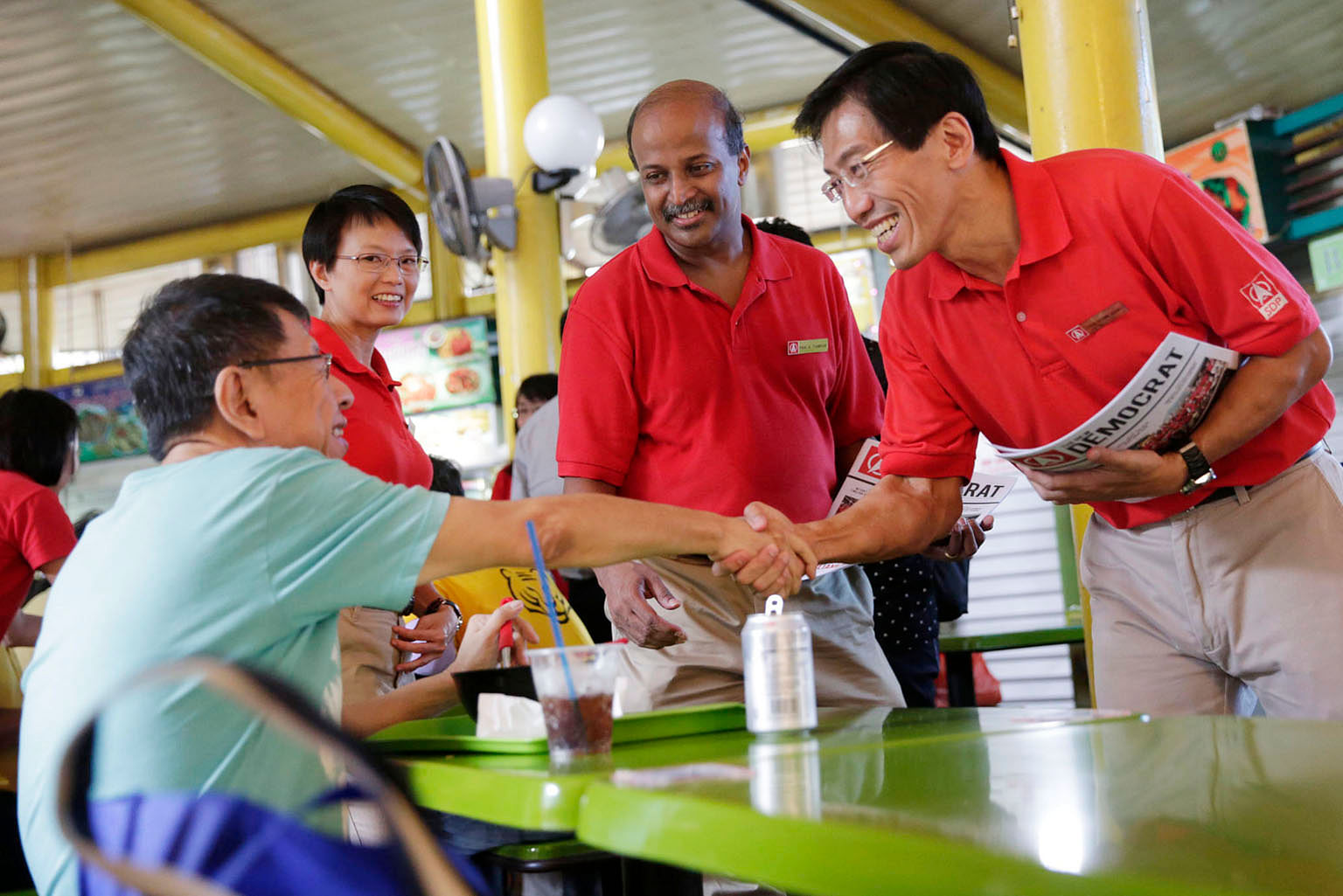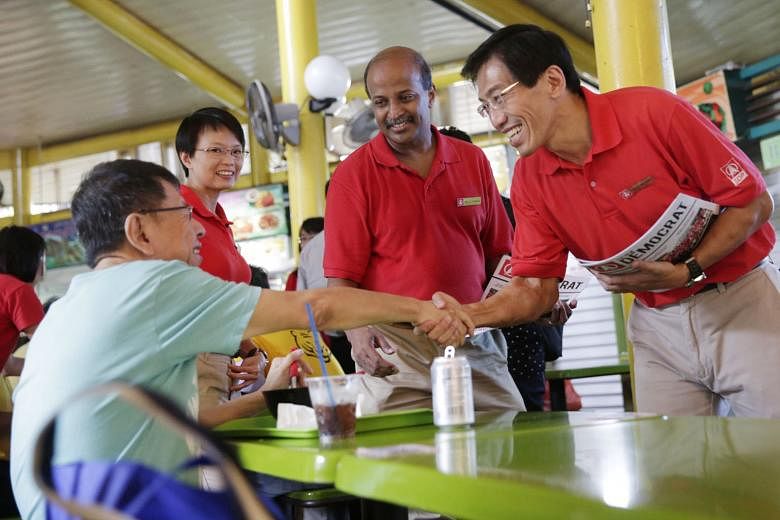Has the Singapore Democratic Party (SDP) become less combative? If so, why and so what?
The latest sign of a change came this month, when the party's new chairman Paul Tambyah told The Straits Times that the SDP would no longer engage in acts of civil disobedience.
It was the party's first public statement to that effect.
Civil disobedience - breaking the law intentionally while advocating change - was a tactic used by secretary-general Chee Soon Juan. He received no fewer than five convictions from 1998 to 2008, such as for holding rallies or protests without a permit.
The SDP has not practised civil disobedience since 2008. But it has never said it was forgoing it - until now. The party was known for other tactics too - such as heckling or making a show of handing letters to foreign diplomats. Such acts appear to also have been discarded.
An explanation for the SDP's evolution was offered by Professor Tambyah, a professor in medicine at the National University of Singapore (NUS). In the pre-Internet era, it was hard for opposition parties to be heard, he said. But there is no need for civil disobedience now because "many of our online posts go viral and reach a far wider audience". In short, confrontation had been a way to broadcast ideas - and there are other ways to do that now.
But there is another explanation for the SDP's change: The earlier approach simply did not work - voters disliked it.
In 1991, the SDP was the leading opposition party, with three elected MPs. After that election, then party chief Chiam See Tong left after a fallout with Dr Chee and other leaders over Dr Chee's hunger strike to protest against his dismissal as a lecturer by NUS for his improper use of research funds.

Mr Chiam's departure spelt the end of an SDP era marked by his moderate style. He continued to hold his Potong Pasir seat until 2011, contesting under other party banners.
In contrast, the SDP failed to hold on to the two other seats won in 1991, losing them at the 1997 election - and has not won a seat since.
Dr Chee, who has a doctorate in psychology from the University of Georgia, took over the party reins in 1993, and employed a much more dramatic style. The SDP's vote share in constituencies it contested fell, vis-a-vis the rest of the opposition: from minus 1.9 percentage points relative to the opposition nationwide in 1997, to minus 10.2 points in 2006.
Some time after 2008, the party turned to less adversarial methods without explaining the shift.
Its relative vote share began to climb: to minus 3.1 points in 2011, and on to positive territory in 2015, at plus 1.1 points. It performed better than most other opposition parties in 2015, though not well enough to make it into Parliament, unlike the Workers' Party (WP).
Post-election surveys by the Institute of Policy Studies (IPS) tell a similar story. Singaporeans who agreed that the SDP was a credible party went up from 19 per cent in 2006, to 24 per cent in 2011, to 46 per cent in 2015 - the steepest rise for any party.
Last year, the SDP fought the Bukit Batok by-election. Dr Chee lost, securing 39 per cent of the votes. Some political watchers say this casts doubt on the SDP's electability under Dr Chee's leadership. Just before he took over in 1993, the SDP's polling average was 48.6 per cent. After 23 years, its electoral performance had declined to 39 per cent.
Others interpret the result differently, noting that the vote share Dr Chee received in Bukit Batok was the highest of his political career, and that this fits the narrative of a changed and rehabilitated SDP.
The 2015 IPS survey showed that the biggest improvement in perceptions about the SDP came from young voters aged 21 to 39. This suggests that those who never had first-hand knowledge of the party's past may have formed more positive impressions after looking at its website, social media posts and performance at rallies. This group could grow over time.
What is less clear is if older voters who remember Dr Chee's earlier, more dramatic approach, and recall the strongly worded criticisms of his character by People's Action Party (PAP) leaders, have revised their view of the party.
What, then, is the significance of the SDP's apparent remake?
The upturn must not be over-interpreted. The SDP was coming back up from a low base. But if the trend continues, there may be significant implications.
First, a continued SDP rise may alter a long-held view among its critics that as long as Dr Chee remains leader, the party will be unelectable; and that only jettisoning him for someone less antagonistic can turn the party's fortunes around.
Some of Dr Chee's opponents also point out that he has chosen not to apologise for his past actions - including his use of factually wrong data at a 1996 parliamentary select committee hearing on healthcare costs. This lack of contrition reflects negatively on his character, his opponents say.
During the Bukit Batok by-election campaign last year, Prime Minister Lee Hsien Loong, for one, said: "Here is somebody that's (up for election) who is able to just gloss over bad things which have been done, and which he has not come to terms with or acknowledged. And he's now presenting himself as a new man - reinvented - and yet, unchanged, and unregretful and unrepentant."
This remains an important point for some voters, who will continue to be sceptical of him and the SDP. But it will also not be lost on observers that Dr Chee's approach of seemingly changing course without saying sorry has brought about a partial but notable recovery in the party's results.
The second implication is that it may be possible one day to imagine the SDP regaining its status as the leading opposition party - a status it enjoyed from 1991 to 1997.
The SDP is now the second-best performing opposition party after the WP. The SDP's recovery furthermore coincides with a difficult time for the WP. The latter is currently embroiled in lawsuits over town council management which could, depending on the outcome, impact the status of several of its MPs. Political watchers also note that the party retained Aljunied GRC in the 2015 election by a mere 2,626 votes, and lost Punggol East.
But should it matter which opposition party is No. 1, and which is No. 2 - given that the SDP and the WP avoid facing each other in three-cornered races?
It matters, because of the situation here, where voters want the PAP in power, and also want enough opposition MPs to balance the PAP. This poses a dilemma for voters who are so minded.
If too many vote for the opposition, there is a remote chance that the PAP may not form the government. If few do, then the checks they seek will not materialise.
As the foremost opposition party, the WP currently enjoys an advantage: There is a perception that voters who have a WP candidate standing in their constituency may tilt towards the opposition, while voters elsewhere will lean more to the PAP, so the overall outcome brings in a PAP government but with some level of checks. It is a "division of labour" of sorts.
If the SDP can claim pole position among the opposition, it could inherit this premium.
But the SDP would be a substantively different opposition from the WP. It has outlined a more comprehensive set of alternative policies and aims to confront the PAP at every turn. It also has ambitions to form a government.
The WP, by contrast, agrees with the PAP not infrequently; is less interested in policy proposals - it says it lacks resources to develop them; and stresses that it is not ready to take over the reins of government.
The WP's stance has drawn criticism, including from opposition supporters who describe the party as being "PAP-lite". Should the SDP make it into Parliament, it is likely to act very differently.
Whether the gap between the SDP and the WP narrows further will be clearer at the next general election. Meanwhile, voters have a few years to consider if the SDP has evolved into the kind of opposition party they favour for the long term.


